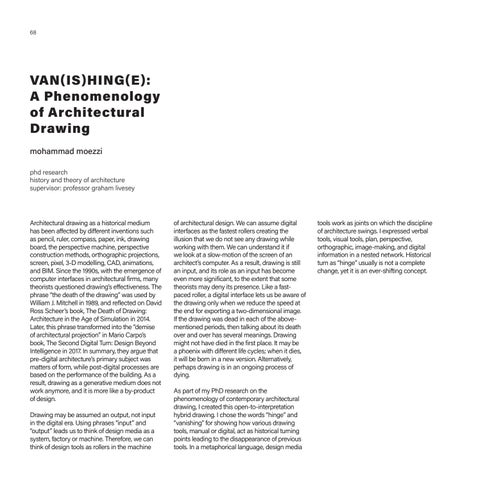68
VAN(IS)HING(E): A Phenomenology of Architectural Drawing mohammad moezzi phd research history and theory of architecture supervisor: professor graham livesey
Architectural drawing as a historical medium has been affected by different inventions such as pencil, ruler, compass, paper, ink, drawing board, the perspective machine, perspective construction methods, orthographic projections, screen, pixel, 3-D modelling, CAD, animations, and BIM. Since the 1990s, with the emergence of computer interfaces in architectural firms, many theorists questioned drawing’s effectiveness. The phrase “the death of the drawing” was used by William J. Mitchell in 1989, and reflected on David Ross Scheer’s book, The Death of Drawing: Architecture in the Age of Simulation in 2014. Later, this phrase transformed into the “demise of architectural projection” in Mario Carpo’s book, The Second Digital Turn: Design Beyond Intelligence in 2017. In summary, they argue that pre-digital architecture’s primary subject was matters of form, while post-digital processes are based on the performance of the building. As a result, drawing as a generative medium does not work anymore, and it is more like a by-product of design. Drawing may be assumed an output, not input in the digital era. Using phrases “input” and “output” leads us to think of design media as a system, factory or machine. Therefore, we can think of design tools as rollers in the machine
of architectural design. We can assume digital interfaces as the fastest rollers creating the illusion that we do not see any drawing while working with them. We can understand it if we look at a slow-motion of the screen of an architect’s computer. As a result, drawing is still an input, and its role as an input has become even more significant, to the extent that some theorists may deny its presence. Like a fastpaced roller, a digital interface lets us be aware of the drawing only when we reduce the speed at the end for exporting a two-dimensional image. If the drawing was dead in each of the abovementioned periods, then talking about its death over and over has several meanings. Drawing might not have died in the first place. It may be a phoenix with different life cycles; when it dies, it will be born in a new version. Alternatively, perhaps drawing is in an ongoing process of dying. As part of my PhD research on the phenomenology of contemporary architectural drawing, I created this open-to-interpretation hybrid drawing. I chose the words “hinge” and “vanishing” for showing how various drawing tools, manual or digital, act as historical turning points leading to the disappearance of previous tools. In a metaphorical language, design media
tools work as joints on which the discipline of architecture swings. I expressed verbal tools, visual tools, plan, perspective, orthographic, image-making, and digital information in a nested network. Historical turn as “hinge” usually is not a complete change, yet it is an ever-shifting concept.

















